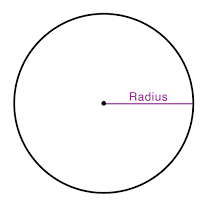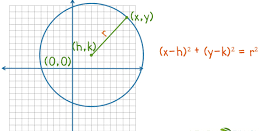
Have you ever looked at a pizza, a clock, or a coin and wondered what makes it so perfectly round? The answer is simply the radius of a circle.The radius is the distance from the center of the circle to its edge, and it’s the same all the way around.
This simple idea helps us understand circles better, from their size to how we measure them. In this blog, we’ll explain what a radius is, how to find the radius of a circle , and share some solved examples to make learning easy and exciting!
Read More - Area of a Circle Definition, Formula, Examples, Real Life Application
What is Radius?
Let’s say you have a circle, and you mark a point right in the middle. From there, if you draw a line to any point on the edge, that’s your radius.Now imagine two kids, A and B, standing on the edge of a round playground, and both are the same distance from the center pole. If we draw a line from the center to each of them those are called radii (plural of radius).
So, according to the definition of radius of a circle, these lines will always be equal.
The radius is the distance from the center of a circle or sphere to its outer edge. It is an important measurement for shapes like circles, spheres, cones with circular bases, and cylinders with circular ends. In a circle, the radius is the constant distance between the center and any point on its boundary. A circle is made up of all points that are the same distance from its center, and this distance is called the radius.The simple definition of the radius of a circle is: a straight line from the center to any point on the circle.
Radius Definition
The radius is the fixed distance from the center of a circle to any point on its boundary, known as the circumference. It remains constant for a given circle and is equal to half the length of the diameter. Represented by the symbol ‘r’, the plural form of radius is “radii.” For example , in the figure below, points A, and B, lie on the boundary of the circle. These two points are equidistant from the center O. As a result, the line segments OA and OB are called the radii of the circle. Their lengths are equal, so OA = OB
How to Find the Radius of a Circle?
Even artists and architects use the circle radius formula to make perfect circles. The radius of a circle can be calculated using three main formulas based on the given parameters: diameter, circumference, or area. Let’s now learn to find the area of a circle using different formulas:If the diameter of a circle is known
The diameter is a straight line that passes through the center of the circle, connecting two points on its boundary. It is twice the length of the radius, making the radius half the diameter. This relationship is expressed as: Radius = Diameter/2 For example , if the diameter of a circle is 10 units, the radius will be 10 ÷ 2 = 5 units.Read More- Diameter of a Circle Definition, Formulas, and Steps
Why Is the Radius of a Circle Always the Same?
The most interesting part of a circle is that no matter where you start from the center, the radius of a circle stays the same. That’s what makes a circle “perfect.”
This special quality helps us create circles in art, maths, and even in toys. The definition of radius of a circle tells us that the same distance creates the round shape.
If the circumference of a circle is known
The circumference is the perimeter of a circle, representing the distance around it. The relationship between the radius and circumference is given by: C=2πr Here, C is the circumference, r is the radius, and π is approximately 3.14159. Rearranging the formula to find the radius:Radius = Circumference/2π
For example , if the circumference of a circle is 31.4 units, the radius can be calculated as: Radius = 31.4/2π ≈ 5 units.If the area of a circle is known
The area of a circle represents the space it covers and is related to the radius by the formula: A=πr 2 Where A is the area and r is the radius. To find the radius from the area:Radius = Area/π
For example, if the area of a circle is 78.5 square units, the radius can be calculated as: Radius = 78.5/π ≈5 units.Radius Formula
|
Radius Formula |
|
| Radius of a circle formula when circumference is given | C ⁄ 2π |
| Radius of a circle formula when diameter | d ⁄ 2 |
| Radius of a circle formula when area is ivgen | √(A ⁄ π) |
Read More - Circumference of a Circle: Meaning, Formulas, and Solved Examples
Radius of a Sphere
A sphere is a three-dimensional solid shape, and its radius is the distance from the center to any point on its surface. The radius of a sphere can be calculated using the given volume or surface area.When the volume of a sphere is given :
The volume of a sphere measures the total space enclosed within it. When volume is given, the radius of a sphere is calculated using the following formula:R= 3 √{(3V) / 4π} units
Where:- V is the volume.
- R is the radius of the sphere, and
- π is a mathematical constant approximately equal to 3.14
When the surface area of a sphere is given :
The surface area of a sphere is the total area of its outer surface. When surface area is given, the radius of a sphere is calculated using the following formula: R = √(A / 4π) units Here,- R is the radius of a sphere.
- A is the surface area of a sphere, and
- π is a mathematical constant approximately equal to 3.14
Radius of a Circle Equation
The equation of a circle on a Cartesian plane with center (h,k) is: (x−h) 2 + (y−k) 2 = r 2 Where (x,y), and r is the radius. If the center of the circle is at the origin (0,0), the equation simplifies to: x 2 + y 2 = r 2 The radius is then given by r = x 2 + y 2
Relation Between Radius and Diameter of Circle
The radius and diameter of a circle are directly related. The diameter is twice the length of the radius, as it spans the entire circle through its center. Mathematically, Diameter = 2 × Radius, or Radius = Diameter/2. This relationship helps calculate one when the other is known.Radius Facts
-
The radius is always half of the diameter.
-
The longer the radius, the bigger the circle!
-
If you know the radius of a circle, you can find the area and circumference.
-
Builders use the circle radius formula when making round windows or water tanks.
-
A compass tool in geometry class works because of the radius of a circle!
-
Learning how to find the radius of a circle is not just for school, it's for real life also.
Radius of a Circle Solved Examples
Example 1: Calculate the radius of a circle with a diameter of 22 cm. Solution: Given, Diameter of the circle, d = 22 cm Using the formula:Radius=Diameter/2
Radius = 22/2 cm = 11 cm Hence, the radius of the circle is 11 cm.| Related Articles | |
| Area of Rectangle | Isosceles Triangle |
| Composite Numbers | Differentiation |
| Perimeter of Rectangle | Surface Area of Cylinder |
Radius of Circle FAQs
How does radius affect the circle's size?
Is the radius always the shortest distance to the circle?
Which units are used for radius?
Can a radius extend beyond the circle?
Can a circle have multiple radii?
Is the radius the same in all parts of a circle?









